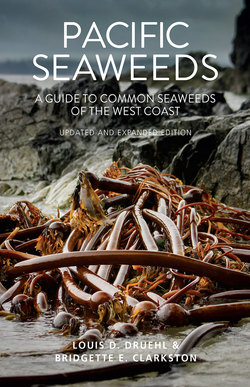Читать книгу Pacific Seaweeds - Louis Druehl - Страница 49
На сайте Литреса книга снята с продажи.
ОглавлениеGreen Seaweeds | 49
Green Seaweeds
Green seaweeds are part of a larger group, the green algae (the division Chlorophyta), which inhabit almost every conceivable habitat—soil, snow, air, and inside rock and polar bear hair. There are approximately 6,000 green algal species, most of which are associated with fresh water. The greens are distinct from the brown and red seaweeds by virtue of their pigmentation, the chemical nature of their storage products and cell walls, and ultra-structural details such as chloroplast (cell structure responsible for photosynthesis) and flagella (whip-like appendages for movement). All green plants have similar pigments, with chlorophyll being the dominant form, which accounts for their green colour. The major storage product of most green plants is starch.
The marine green seaweeds of our area are represented by swimming and non-swimming unicellular forms, filaments, sheets, and globular and cushion-like forms. Close to 130 green seaweed species are recognized locally. Here we describe five basic forms and 40 species that represent the diversity found from Alaska to central California. Most included species are distributed through southern California into Mexico as well.
Washed-up Ulva sp. blades cover the beach in Comox, BC.
